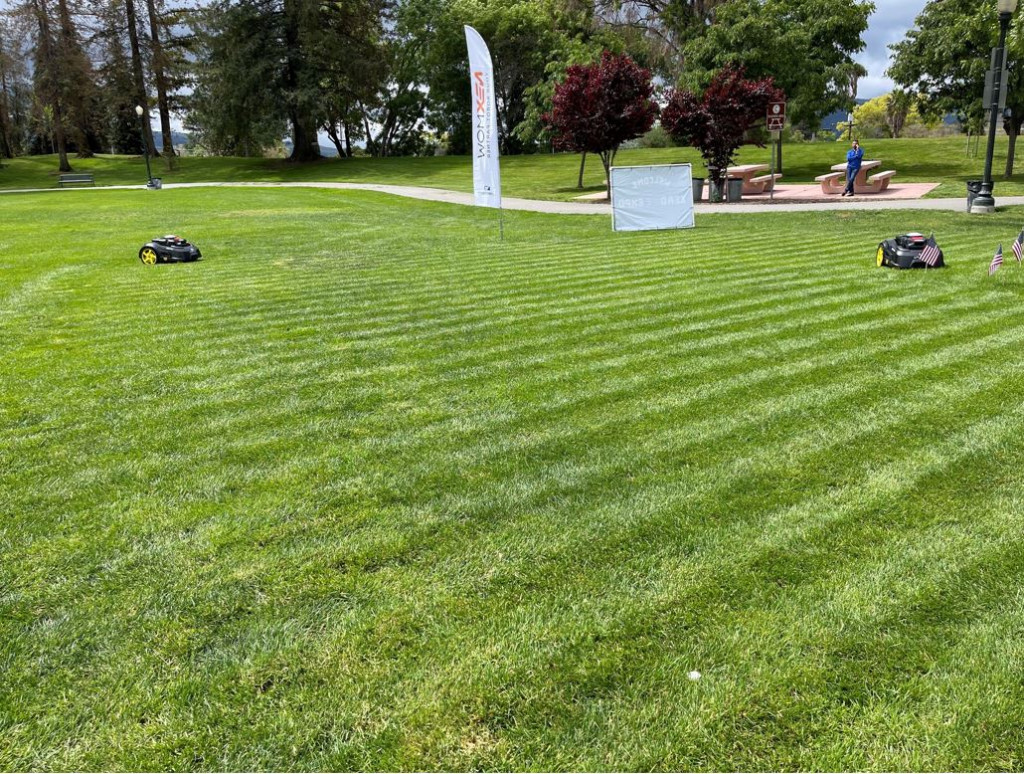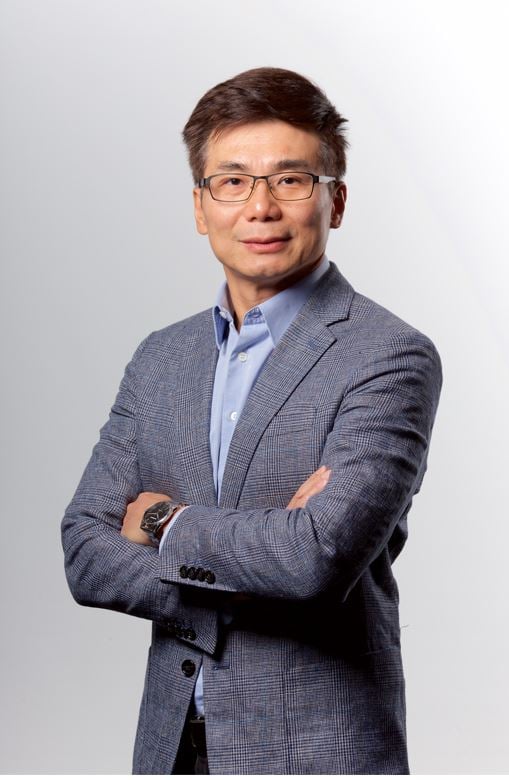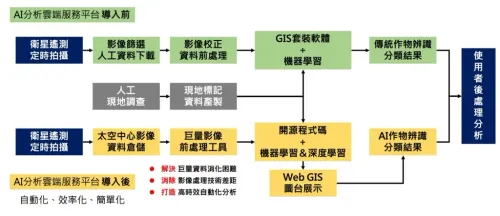【2022 Application Example】 USRROBOT's AI Lawn Mowing Robot Enters the Blue Ocean of Golf Market
An AI smart lawn mowing robot, resembling a vacuum robot, shuttles back and forth on the 30-hectare golf course lawn for weeding. This robot, independently developed and designed by Taiwanese, is equipped with the world's first electronic fencing positioning technology which utilizes high-precision GPS integrated with cloud AI computation to determine the most efficient mowing paths, targeting the lucrative blue ocean market of golf courses.
This AI lawn mowing robot was developed by USRROBOT, a Taiwanese startup established in 2019. Chao-Cheng Chen, the president of USRROBOT, once served as the executive vice president of one of the top five ODM tech companies in Taiwan, and specializes in software and hardware integration. When he served as the chairman of the Service Robot Alliance, he knew that the service robot industry was bound grow rapidly due to declining birth rates and the growingly severe labor shortage.
New demand - The horticulture market is large and the has rigid demand
"To develop the core technology of service robots, we must find rigid demand. Looking at European and American countries, there is a shortage of labor, but demand for horticulture has increased, and there has been a long-term shortage of 7-10% of horticultural workers." Under this strong "rigid demand," Chao-Cheng Chen established USRROBOT, and the company's first product is the AI lawn mowing robot.
In terms of overseas markets, the United States is the world's largest horticulture market, accounting for 30%-40% of the global output value. It is estimated that there are about 1 million horticulture workers, but they have been experiencing a labor shortage of 7%-10% in recent years and have not been able to improve the situation. The main reasons for labor shortage are: Aging population and gardening is a labor-intensive job, so young people don't want to do it. Unlike in Taiwan, European and American countries attach great importance to lawn maintenance and have expressly stipulated in the law that heavy fines will be imposed for failing to mow the lawn. Therefore, the AI lawn mowing robot has considerable market development potential.

▲ The introduction of AI multi-device collaborative mowing sensor technology is expected to reduce the burden of staff maintaining the golf course
The AI lawn mowing robot developed by USRROBOT is currently in its second generation. Domestic universities and well-known art museums are using the latest model M1, and it is also being used by some world-renowned high-tech companies and well-known universities in the United States. The company is currently involved in negotiations for subsequent business cooperation.
USRROBOT stated that the professional RTK system currently used can reduce the original GPS positioning error from tens of meters to about 2 centimeters, allowing the robot to move accurately outdoors. After setting the boundaries, it can be easily operated using the app.
New application - Implementation in golf courses solves the problem of labor aging and shortage
Chao-Cheng Chen further explained that the National Land Surveying and Mapping Center is a RTK service provider. RTK provides the error reference map of the positioning point. USRROBOT can access the positioning error value of a specific position through 4G Internet access. The AI algorithm of USRROBOT reduces the general 10-20 m error of GPS to 2 cm. After positioning, USRROBOT then uses six-axis accelerator positioning, gyroscopes, and wheel differential sensing devices for software and hardware integration. Only by matching the wheel's movement pattern and the terrain can accurate mowing path planning be achieved.
The AI lawn mowing robot, which is 62 cm wide, 84 cm long, 46 cm high, and weighs only 25 kg, can set the mowing boundaries in the cloud. It can avoid pools and sand pits through settings, using AI algorithms to automatically calculate the optimal path. It is able to mow approximately 150 ping of grass in one hour. The battery can be used continuously for more than 6 hours. The battery life is currently the highest in the world. In addition to general gardening companies, with the assistance of the AI project team of the Industrial Development Bureau, Ministry of Economic Affairs, USRROBOT's AI lawn mowing robot has been applied to golf course lawn mowing.
A well-known golf course located in Taiping District, Taichung City currently has a staff of 5 people who are responsible for the lawn, planting maintenance, and other landscape maintenance of the entire 30-hectare course. However, the average age of staff is as high as 55 years old, and the golf course has been unable to recruit new staff members for a long time. In view of the aging staff and the shortage of manpower, the golf course hopes to mitigate the impact with AI technology, and is therefore using AI multi-device collaborative mowing sensor technology, in hopes of reducing the burden of staff maintaining the golf course.
New challenges - Expert systems are needed to overcome difficulties with different grass species
"This AI lawn mowing robot has low noise, low pollution, low labor costs, and is waterproof and anti-theft. In the lawn mowing process, it can identify and avoid obstacles through ultrasonic sensors while maintaining mowing quality, maintaining aesthetic and consistent grass length." Chao-Cheng Chen went on to say that the most important part about golf courses is that the grass pattern should be beautiful and free from diseases and pests.
Based on the site survey, golf courses are mainly divided into three major areas: green, fairway and rough. There is no problem using the current mowing robot to mow the rough area, and it can overcome slopes within 20 degrees.The short grass in the fairway area may only be two centimeters long, and the grass types are also different, so the cutterhead design needs to be modified.As for the grass in the green area, the grass must be mowed close to the ground and maintained in a consistent direction because it affects the putting speed. Many factors will affect the green index, and this part requires more research and testing.

▲ The AI lawn mowing robot can identify and avoid obstacles through ultrasonic sensors while maintaining mowing quality
The AI smart lawn mowing robot has a built-in camera that can be used to detect the health condition of the lawn. Chao-Cheng Chen said that in the future, an expert system will also be introduced for early determination of whether there are diseases, pests in the lawn or whether there is sufficient moisture, and provide lawn health data analysis to customers, so that they can take preventive and response measures sooner to reduce disaster losses.
Chao-Cheng Chen, who is also a good golfer himself, said that golf has developed well in Taiwan. However, due to weather factors, such as rainy and humid climate and typhoons, Taiwan's golf courses have harder soil and more potholes compared with top tier golf courses overseas. If AI lawn mowing robots are to be widely introduced into golf courses, there are still many difficulties that must be overcome. However, Taiwan's difficult terrain creates a good testing ground. Once Taiwan can overcome the many problems and successfully introduce the robot, it will be able to expand to overseas markets and seize new market opportunities in a blue ocean.

▲ Chao-Cheng Chen, President of USRROBOT


